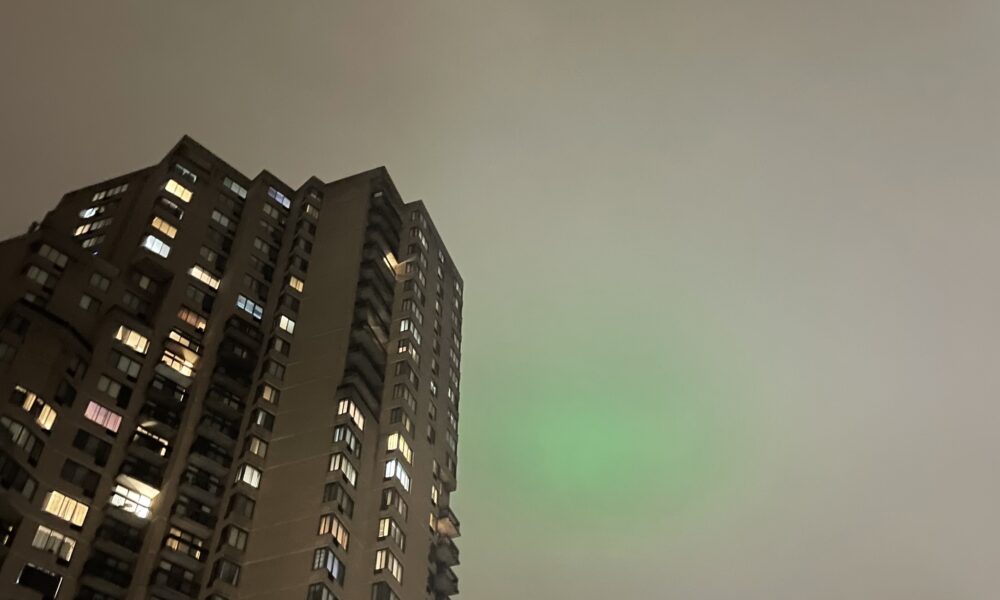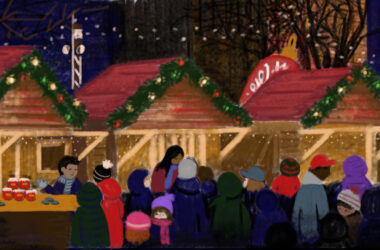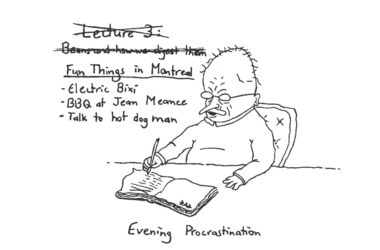It’s the neverending question lingering in the back of everyone’s mind, the eternal darling in the dark of Montreal urban legend—the unspoken elephant in the room, if that elephant were green and also floating a hundred metres in the air. For decades, there have been reported sightings of an ominous green sky patch of twilight, disturbing the usual white halo of light pollution over downtown. This experience has become so widespread that it has lovingly been dubbed “the Montreal green light.”
The Montreal green light is much more than your average folie à deux; it’s a very real enigma that haunts the recent memory of all who have encountered it. Like a mirage, it’s faint, hardly even there—never less than an arm’s length away, never more than shoulder-width apart. Nietzsche once said that if you gaze into the abyss long enough, the abyss will also gaze back into you. But does the abyss also use progressive lenses or is hindsight actually always 20/20? Only time and a little research might tell who or what this green light precisely is.
Upon interviewing students on campus, I quickly noticed that while the experience of seeing the light is nearly universal, the interpretations of it varied fiercely.
Karman Dhesi, U1 Science, reported sentiments shared in her social media circles, where the green light is interpreted as a UFO or some semblance of supernatural alien presence. Contrastingly, Ash Chen, U1 Science, said that many of her international friends express a fond recollection of the light as an aurora borealis sighting. Especially her friends coming from regions nearer the equator seem to disproportionately believe in the concept of the green light as an organic uniquely northern meteorological phenomenon.
Though having never seen it in person, Helen Zhao, U2 Science, is convinced that it is the consequence of some sort of man-made incident.
“Possibly failed fireworks, maybe a plane passing by or some sort of accident,” she said in an interview with The Tribune.
And she isn’t the only one who is skeptical of a man trying to play god and flying just a little too close to the green sun. Riana Dutta, U3 Engineering, has suggested that corporate greed might be to blame.
“I’ve been seeing it a lot more frequently now that you mention it, I used to think that it was global warming or pollution but something tells me it might be like a publicity stunt for the theatrical release of Wicked,” Dutta said.
One thing remains universal: People want to know where this giant green haze is coming from. Like moths to a very green flame, the light straddles a thin line between being infamous and famous.
When I turned to Google, it turned out to be easy to find that the real culprit was light pollution all along. The internet really does ruin everything. The light casts a shadow against prime suspect number one: The Desjardins Complex.
You may be wondering how a building on the ground could project light hundreds of meters into the sky? Well, it’s elementary, my dear Watt-son. Instead of using a wide selection of halide lights to project light outwards, the bank has chosen to install industrial-scale LED lamps at the base of the building, firing light upwards—a controversial decision with light pollution activists that also raises ethical questions about the use of public space for corporate advertisement. This creates a gradient of green across the building, with all the excess firing off into the sky. Though most winter evenings the beam goes unnoticed, when the stars align and the clouds catch the light just right, they disperse it into the foreboding green halo that we all think of today.
Despite the green light being a product of light pollution, it serves as a beacon of hope in literal dark times.
“Ah, the Montreal Northern Lights. During winter when it gets dark out early and people are smoking and it’s freezing or depressing, it becomes sort of a little talking point. A recurring source of levity that kind of gets brought up when morale is low,” Jillian Ludl, U1 Arts, said.







